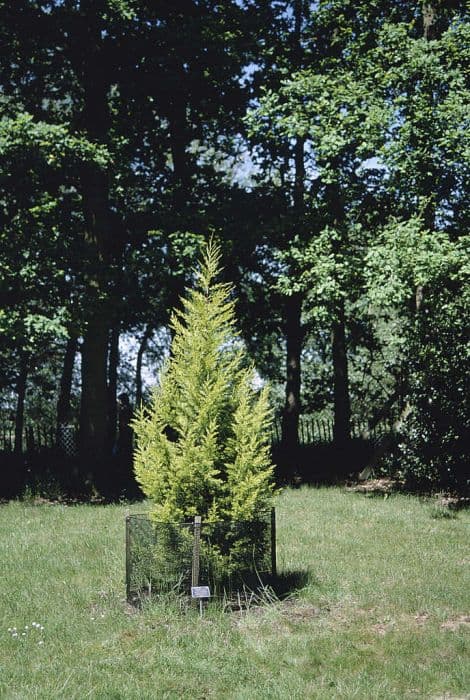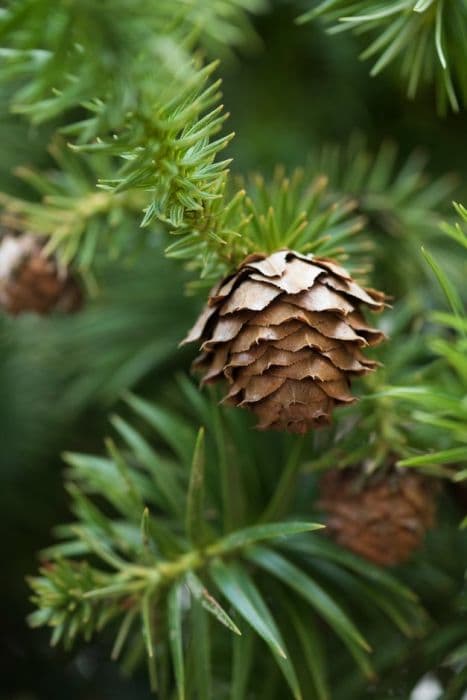Arizona Cypress Cupressus arizonica 'Pyramidalis'

ABOUT
The Arizona Cypress 'Pyramidalis' is an evergreen conifer known for its strikingly dense and columnar shape. The foliage of this plant is a rich, blue-green color, consisting of small, scale-like leaves that tightly overlap along slender branches, giving it a somewhat textured look. The leaves may also have a glaucous, or slightly grayish, wax coating that adds to the blue tint of the foliage. As the name 'Pyramidalis' suggests, the plant's overall growth habit is pyramid-like, with a broader base tapering smoothly up to a sharp point at the top. The branches of the Arizona Cypress 'Pyramidalis' extend outward from the central trunk forming a compact, conical silhouette. This tightly packed branch structure provides dense coverage, making it an excellent choice for a privacy screen or a windbreak when planted in a row. The bark on the trunk and main branches is fibrous and stringy with a reddish-brown color that provides a pleasing contrast with the blue-green foliage. During the growing season, the Arizona Cypress 'Pyramidalis' may bear small, round cones that start off green and mature to a woody brown color. These cones are generally modest in size and add to the decorative appearance of the tree. With its striking form and attractive foliage, the Arizona Cypress 'Pyramidalis' is a popular choice for landscapes needing vertical accents or formal hedges without taking up a large footprint. Its beauty and versatility make it a sought-after specimen for both residential and commercial planting schemes.
About this plant
 Names
NamesFamily
Cupressaceae
Synonyms
Arizona Cypress, Pyramidal Arizona Cypress, Pyramidalis Arizona Cypress, Carolina Sapphire, Blue Ice
Common names
Hesperocyparis arizonica 'Pyramidalis'.
 Toxicity
ToxicityTo humans
Arizona cypress is not generally considered toxic to humans. However, ingesting any part of the plant may cause mild gastrointestinal upset in some individuals due to the unusual compounds plants contain. There is no well-documented evidence of serious toxicity or severe poisoning symptoms in humans following ingestion of parts of the Arizona cypress.
To pets
Arizona cypress is also not known to be toxic to pets. Similar to humans, ingestion might result in mild gastrointestinal discomfort, such as vomiting or diarrhea, due to the plant's natural compounds. No severe toxicity or life-threatening signs are typically reported in pets after ingesting this plant. However, it's always prudent to keep an eye on pets if they have ingested any part of the plant, and consult with a veterinarian if any concerning symptoms arise.
 Characteristics
CharacteristicsLife cycle
Perennials
Foliage type
Evergreen
Color of leaves
Blue-green
Height
30-50 feet (9-15 meters)
Spread
10-20 feet (3-6 meters)
Plant type
Tree
Hardiness zones
7
Native area
Southwest United States
Benefits
 General Benefits
General Benefits- Drought resistance: Arizona cypress 'Pyramidalis' is well-adapted to dry conditions, requiring minimal watering once established.
- Windbreak: Its dense foliage and pyramidal shape make it useful as a windbreak to protect landscapes from strong winds.
- Erosion control: The extensive root system can help stabilize soil and prevent erosion on slopes or in areas prone to soil loss.
- Low maintenance: It typically requires little pruning or other care, making it an excellent choice for those seeking a low-maintenance landscaping plant.
- Ornamental appeal: Arizona cypress 'Pyramidalis' has attractive blue-green foliage and an elegant pyramidal form, making it a popular ornamental tree.
- Wildlife habitat: It can provide shelter and nesting sites for birds and other wildlife.
- Privacy screen: Because of its dense growth, it can be planted in rows to create a natural privacy screen or living fence.
- Soil adaptability: This plant can thrive in a variety of soil types, from sandy to clay, as long as the drainage is good.
- Heat tolerance: Arizona cypress 'Pyramidalis' is well-suited to hot climates and can withstand high temperatures without significant stress.
- Seasonal interest: In addition to its year-round foliage, some specimens may produce attractive cones that add to the tree's seasonal interest.
 Medical Properties
Medical Properties- Anti-inflammatory: The extracts from Arizona cypress may have anti-inflammatory properties.
- Antimicrobial: Components of the essential oil may exhibit antimicrobial activity against certain pathogens.
- Antifungal: The essential oil from the Arizona cypress might have antifungal effects against some fungal species.
 Air-purifying Qualities
Air-purifying QualitiesThis plant is not specifically known for air purifying qualities.
 Other Uses
Other Uses- The Arizona cypress 'Pyramidalis' can be used as a sound barrier when planted in dense rows, mitigating traffic noise and creating quieter outdoor spaces.
- Its strong, aromatic wood can be utilized in crafting furniture or decorative items, bringing a rustic aesthetic and woody fragrance indoors.
- With its dense foliage and tall growth habit, the Arizona cypress 'Pyramidalis' serves as an effective privacy screen, shielding homes and gardens from view.
- The wood chips or shavings from this tree are often used in landscaping as mulch, providing soil moisture retention and weed control.
- Dried branches and foliage can be incorporated into floral arrangements or wreaths, lending a natural and long-lasting green touch to decor.
- The tree's striking conical shape makes it a popular choice as a living Christmas tree during the holiday season.
- In large open spaces or parks, the Arizona cypress 'Pyramidalis' is planted as part of reforestation efforts to stabilize soil and prevent erosion.
- Its tall and narrow form can be used to accentuate vertical lines in architectural landscaping, complementing structures like tall buildings or gateways.
- Due to its adaptability to different soil types, Arizona cypress 'Pyramidalis' is used in reclaiming disturbed lands, such as former mine sites, improving the landscape visually and environmentally.
- Wood from the Arizona cypress 'Pyramidalis' can be processed to create essential oils, which are used in perfumery and aromatherapy for their fresh and woody scent.
Interesting Facts
 Feng Shui
Feng ShuiThe Arizona Cypress is not used in Feng Shui practice.
 Zodiac Sign Compitability
Zodiac Sign CompitabilityThe Arizona Cypress is not used in astrology practice.
 Plant Symbolism
Plant Symbolism- Strength: Arizona Cypress 'Pyramidalis' is known for its sturdy and solid evergreen presence, representing resilience and steadfastness.
- Longevity: This plant can live for hundreds of years, symbolizing endurance and the passage of time.
- Protection: The dense foliage and pyramidal shape of the Arizona Cypress 'Pyramidalis' offer shelter and safety to birds and wildlife, representing a symbol of protection and security.
- Eternity: Evergreens like this cypress are often associated with eternal life due to their year-round greenery, which does not die off in the winter.
 Water
WaterThe Arizona Cypress 'Pyramidalis' should be watered deeply and infrequently to encourage a strong, deep root system. A newly planted tree requires watering once or twice a week, applying approximately 10 gallons each time, depending on the size of the tree and the weather conditions. Once established, reduce watering to every two to three weeks, with increased intervals during cooler months. During hot, dry spells, it may need supplemental water. Adjust watering frequency based on rainfall, as the soil should be allowed to dry out between watering.
 Light
LightThe Arizona Cypress 'Pyramidalis' thrives best in full sun, where it receives at least six hours of direct sunlight daily. The ideal spot for the plant is an open area, away from large buildings or shade-providing trees, as this cypress variety prefers ample sunlight to develop its dense, pyramidal form.
 Temperature
TemperatureThe Arizona Cypress 'Pyramidalis' is tolerant of a wide range of temperatures and can survive minimum winter temperatures of about 0°F. It can endure summer heat up to about 100°F. The ideal temperature conditions for this cypress fall between 40°F and 80°F, making it suitable for many temperate climates.
 Pruning
PruningThe Arizona Cypress 'Pyramidalis' typically requires little pruning, which is mainly to maintain its shape or remove dead or damaged branches. Pruning is best done in the late winter or early spring before new growth begins. Thin out dense foliage to allow light into the inner parts of the tree and trim back any wayward branches to maintain its pyramidal shape. Pruning every few years should be sufficient, unless used for a hedge where it may need more frequent trimming to keep the desired form.
 Cleaning
CleaningNot needed
 Soil
SoilArizona Cypress 'Pyramidalis' thrives in well-draining soil with a pH range of 6.0 to 8.0. The best soil mix is one part garden soil, one part sand, and one part organic compost to ensure adequate drainage and nutrient content.
 Repotting
RepottingArizona Cypress 'Pyramidalis' is typically not repotted as it is a large, outdoor tree. Instead, young trees should be planted in a location where they can grow undisturbed.
 Humidity & Misting
Humidity & MistingArizona Cypress 'Pyramidalis' prefers a dry to average humidity environment and is tolerant of arid conditions once established.
 Suitable locations
Suitable locationsIndoor
Place in bright light, ensure pot with drainage, avoid overwatering.
Outdoor
Full sun; well-draining soil; space for roots and canopies.
Hardiness zone
7-9 USDA
 Life cycle
Life cycle'Arizona Cypress 'Pyramidalis'' starts its life as a seed, produced by the mature cones of parent trees, which typically require a fire or a period of dryness to open and release seeds. Once germinated in suitable conditions, it grows rapidly into a seedling, establishing a root system and a small shoot. As it matures into a sapling and then a young tree, it develops its characteristic pyramidal shape with dense, scale-like leaves and begins to produce its own cones after reaching a certain age, which varies but can be several years. Throughout its adulthood, it continues to grow taller and thicker, potentially reaching up to 60 feet in height, and it maintains its pyramidal form. The tree exhibits seasonal changes with growth slowing down during the cold months and accelerating in the spring and summer. It can live for several decades, and upon reaching the end of its life cycle, the tree will ultimately die, decompose, and contribute nutrients back to the soil, supporting the growth of new plants.
 Propogation
PropogationPropogation time
Spring-Early Summer
The Arizona Cypress 'Pyramidalis', commonly referred to as the Arizona Cypress, can be propagated effectively through seed or cuttings. However, the most popular method involves taking semi-hardwood cuttings. This process is typically done in the late summer or early fall when the current year's growth has begun to harden. Cuttings should be about 6 to 8 inches long, including several sets of needles. It is recommended to take cuttings from the middle part of the branches, where the wood is neither too old nor too young. The cut end of the cutting can be treated with a rooting hormone to promote root development and then planted in a well-draining medium such as a mix of peat and perlite kept consistently moist. The cuttings should be kept under a light shade and high humidity until roots have formed, which can take several weeks to a few months.









